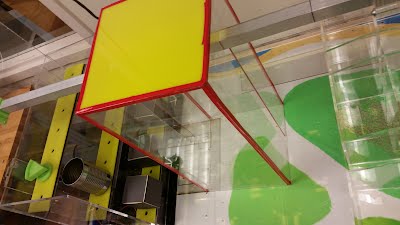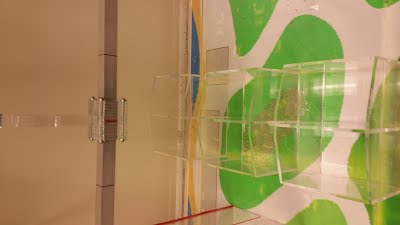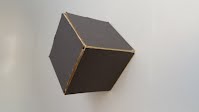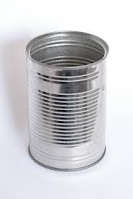Robotic Recycling
MAE3 Spring 2015
UC San Diego is known as a leader in Sustainability. Here in MAE3, we seek to recognize this effort by inspiring engineering students to develop robots that will sort trash into their appropriate recycling dumpsters. In June students will be emptying their dorm rooms and cleaning them out for inspection by the Housing and Dining Hospitality (HDH) Inspector. Engineering students have elected to use their design skills, and build robots to properly dispose of trash and deposit it in the appropriate recycling bins. A model of the dorm and bin locations are shown in the Contest Table below. On each table 2 robots will compete head to head to see which one removes more trash from the dorm rooms and deposits them in the appropriate bins.
Contest Table
At the beginning of the contest each robot will start in a designated 10x10x21in starting area. The bottom floor of the dorms contains Cardboard Box trash, the second floor contains Metal Can trash, and the third floor contains Decomposing Food destined for the Compost Heap. Images of the trash are: | | | | | | | Cardboard Box Trash | Metal Can Trash | Food Waste 1
| Food Waste 2 | Food Waste 3 |
In the center of the table is a Cardboard Recycling Dumpster on the right side, a Metal Recycling Dumpster on the left side, and a Composter in the middle. Each team will have their own bins on their side of the table. The goal of the contest is to remove the trash from one's dorm and deposit it in the appropriate bin. The HDH Inspector will be observing the cleaning process from on top of an Outlook Beam. Students will not be allowed to leave for summer break without approval from the HDH Inspector; thus each team wants the inspector on their side (by which we mean literally on their side of the table). Contest scoring is as follows: - 1 point for each item of trash completely removed from the dorms. No part of the trash may be within the confine of the dorms to count, but the 1 point score is valid even if the trash falls off of the contest table.
- 2 additional recycling points for each metal can deposited in the Metal Recycling Dumpster.
- 3 additional recycling points for each cardboard box deposited in the Cardboard Recycling Dumpster.
- 4 additional recycling points for each decomposing food items deposited into the Composter.
- Pulling the HDH Inspector onto one's side of the table will add 1 additional recycling point for each trash item placed properly in a bin. Note, pulling the inspector onto ones side of the table without a trash item in a bin will results in no additional points, but it will serve as a tie breaker. For the HDH Inspector to be considered on one side of the table he/she must be pulled completely past the designated mark.
For a piece of trash to gain a recycling point, at least part of the trash must be below the top of the corresponding dumpster or composter Placing robot parts in a dumpster of composter is allowed and will not impact scoring. Trash from one dorm that is deposited into the opposing dumpster or composter will not count for any recycling points. The Outlook Beam passes through the starting area of each robot. Robots may start on the Outlook Beam, drop from the beam, or climb onto the beam during the contest. Robots can also be bolted to threaded holes in the lower playing surface. The robot contest will last for 60 seconds, and all scoring will be done at the completion of the contest after all parts have finished moving. There is a maximum of a 2 minute setup time during which robots must be loaded onto the contest table and be ready to go.
What is allowed:
- Robots can interact, cover opposing bins, or even move trash in an opponent's bin. However, robots that are designed to damage another robot will be disqualified. See details rule below.
General MAE3 Competition rules:
A complete list of rules is provided at the end of this document, and any clarifications to the rules will be posted at the end of this webpage throughout the quarter. However, some key rules are:
- Robot setup time on the contest table cannot exceed 2 minutes.
- Manufacturing variations will exist between playing fields. It is the team's responsibility to design a robot that will work on all contest tables.
- The robots will be arbitrarily assigned to start in either the right or left starting areas.
- Each robot must only be built out of kit parts provided.
- Robots must be built in the Design Studio only using Design Studio tools.
- The disassembled robot must be able to fit in the team's locker, where it must be stored.
- Robots may be designed to interact. However, it is not in the spirit of the competition to intentionally damage another machine and no part of the kit may be used in a manner that is intended to cause harm. Any device which is designed to chop, break, or penetrate another machine will not be allowed to compete. If you think your machine may be at risk for violating this rule, ask early before you build it!
- Applying forces onto an opposing team’s robot that are large enough to break plastic pasts, while the opposing robot is in its starting area, will be deemed to be intentional harm to an opponent and can lead to disqualification.
- However, blocking other robots or pushing other robots while attempting to score will generally be considered legal.
- Robots will compete in a head-to-head competition. However, operation of the robot without an opponent will be an important part of the robot grade.
Electrical Power
The robots must be powered solely from electrical power transferred through the power cord, and from potential energy stored in the robot at the start of the contest. The kit includes 2 geared DC motors, 3 non-geared DC motors, and one solenoid. Electrical power will be provided from a power supply with a maximum of 5VDC output. The power will be controlled by the following switches:
Two Fixed 5 Volts DC switches
Two Variable Voltage switches (0 to 5VDC) with a user controlled knob to adjust the voltage.
Each switch is Double Pole Double Throw (DPDT) switches, which can operate a DC motor in either direction. Note the kit contains five DC motors and one solenoid, but only four user controlled switches. More than one electrical device can be connected to a single switch, but the voltage may drop if a large current draw is placed on the power supply. Use of motors, solenoids, and switches will be covered in lecture and is described in the course pack.
Review the Power Supply and Multimeter Use carefully. Issues with the electrical power often occur with the Variable Voltage switches, since the maximum current output is less in these switches. The non-geared motors draw high current and startup problems may occur if multiple non-geared motors with high loads are tied to the variable voltage source!
Kit Parts and Use Guidelines
Each machine must be constructed solely from materials provided in the Kit Parts list (List attached below). Some key points on these guidelines are:
- No foamcore in final robot (as stated in kit parts list).
- The wire and string are serve your self, but are limited in length as noted.
- The paper cover on the acrylic parts is not to be used as a separate part. If it is detached from the acrylic it must be discarded.
In addition to the kit parts listed in the table, the following items may be included in the machine:
- Nuts, bolts, and washers included in the Design Studio bin. These include bolts from size 2 to size 10, and metric screws for mounting the motors.
- Only take nuts and bolts from the bin as you need them, and search through the spare bolt bin before taking more (we went through $1,500 in fasteners last year!)
- Adhesives; including hot melt glue, and acrylic adhesive.
- Tape used ONLY for electrical insulation
- Lubricants used only to reduce friction within one's machine (not on the contest table).
- Nonfunctional decorations.
Replacement Material Policy
We have some extra material that can be used for experimentation. This material will be made available in the lab scrap bins. In addition each section tutor has access to a limited amount of replacement material for their section. If you need replacement parts, contact your tutor. Some replacement of "mistakes" made to kit parts will be available, but supplies are limited, and replacement is not guaranteed.
3D Printed Parts
Each team may have parts made in the Design Studio's 3D printers under the following guidelines. - The combined volume of all 3D printed parts, may not exceed 100 cubic inches per team.
- Team members must create the CAD files for all 3D printed parts, except for gears, timing belt pulleys, and selected parts such that will be posted on the MAE3 webpage.
- Teams can experiment with 3D printing and parts that are not used on the robot will not count towards the team's total. However, priority to the 3D printer will go to students working during their section time and to teams which have not yet used to 3D printer as much. Use of the 3D printer may be heavy during the final weeks of the class, so do not count on readily available access at that point.
Contest Event Description
The contest will be held during the MAE finals period and will be open to the public. The contest will be held in a single elimination fashion (like a tennis tournament). During the lab period of the last week of classes, each section will hold a section-wide contest. The results of this contest will be used to seed the placement of the final contest. Thus teams that perform better during their section contest will have statistically easier contests in the early rounds. Since the number of teams in the class will not be exactly a power of 2, the higher seeded teams may get a "bye" during the first round. If necessary "wild card" teams will be selected to have a second chance in the contest, to ensure that all pyramid spots are filled.
Performance in the contest depends on numerous factors that do not relate to engineering quality of the robot, including driving skill and luck! The grade for the project will not be adversely affected by poor performance in the contest, but will be based upon:
- Performance of the machine without an opponent. A video record of the robot performance at its best should be the team's oral presentation.
- Effective communication of the design (orally and in final reports).
- Documentation of the design process and justification of decisions made.
- Analysis of machine performance in the robot reports.
- Following good design practices.
A trophy will be presented to each member of the winning teams, and a number of machines will be selected for display in the Design Studio. Team members must work out among themselves who will keep the final machine (after their display period). Teams will post presentations and video of their robot on the class web page, which they can cherish forever.
Expanded Rules List
Only the tools and machine equipment in the Design Studio can be used to build the robot.
Energy Sources: The energy used by the devices in the competition must come solely from:
Potential energy derived through a change in altitude of the center of gravity of the machine
Potential energy achieved by the deformation of the springs provided by the Kit
Electrical energy derived through the umbilical during the 60 seconds when the power supply is energized.
Umbilical Cables: The electrical connections will made to a single umbilical cord hung from above the table; one on each side of the table. The umbilical cord cannot be touched during the contest, and there will be some drag from the cable. Each machine must be designed to overcome this drag if necessary for motion of the machine. If requested a TA can ensure that the umbilical cable does not snag.
Detailed Rules
- Judges and/or instructors will disqualify any device that appears to be a safety hazard.
- Any machine that has flying parts must notify opponents, and all contestants must wear safety glasses during the machine operation.
- If a projectile is used, for reasons of safety, it must have a frontal area greater than 2 inch squared.
- Contestants will randomly be assigned to start on either side of the playing field.
- A maximum set-up time of 2 minutes will be allowed at the contest table.
- A maximum of 1 minute will be allowed for removal of all parts of each machine after each contest.
- Operators may interact with their machine during a contest only through normal operation of the switch boxes (for example you cannot touch the machine with one's hands during operation).
- It is allowable to adjust the configuration of the machine between contests; for example adjusting the configuration to the side of the playing field the machine starts on.
- Each machine can only interact with the surface of the playing field and objects on the playing field.
- The judges will wait until all the playing pieces have stopped moving before determining the winner.
- Points will be awarded based upon the final location of the playing pieces, regardless of which machine moved them.
- A playing piece will be declared out-of-bounds if it is off the playing field.
- Damaging the playing field or the control boxes may result in disqualification.
- Purposefully using the electrical cables for any purpose other than transmitting electricity is not allowed.
- Gaining traction by use of adhesives, or by abrading or breaking the surface of the playing field is not allowed.
- A machine may not contaminate with lubricant or other substance the playing field or an opponent's machine (internal lubrication of a machine is permissible).
- Kit materials may not be changed chemically. DC Motors may not be rewound.
- The paper that is attached to the acrylic in the kit cannot be used as a separate element in the machine. If any piece of paper is detached (even partially) from the acrylic it must be discarded.
- The insulation must remain on the electrical wire in the kit except where the wire end is attached to another component, and there up to 0.5” of insulating can be removed.
- The clear acrylic 0.25 thick is for testing. If you include any of this acrylic in your final machine, you must remove an equivalent amount of colored acrylic that was used in making the part.
- Spare parts are available on a limited basis. Students should go to the tutors of their section to receive replacements for parts broken. Student can purchase replacement acrylic from upper campus machine shop or off campus (see door of Chris Cassidy's office for sources)
- Machines may be designed to interact. However, it is not in the spirit of the competition to intentionally damage another machine and no part of the kit may be used in a manner that is intended to cause harm. Any device which is designed to chop, break, or penetrate another machine will not be allowed to compete. If you think your machine may be at risk for violating this rule, ask early before you build it! (see rule clarifications)
- Machine advertisements and decorations must be of the nature that it does not offend any other students or audience participants (use common sense!).
- All rulings of the judges will be final.
MAE 3 Robot Kit part List for Spring 2015
|




